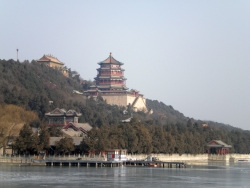Beijing Ancient Observatory, Summer Palace and Jingshan Park
Saturday, January 15th, 2011In my final days of this trip I visited Beijing Ancient Observatory, the Summer Palace and Jingshan Park.
The Beijing Ancient Observatory was first established in 1442 in the Ming Dynasty, and is one of the oldest and longest operating astronomical observatories in the world. I explored the observatory grounds and buildings where there good interpretive displays on ancient astronomy, the history of the observatory, and the functions and operation of ancient astronomical equipment. I then climbed the ancient stairs to the observatory platform, located on top of a tower that was part of the old city wall, where there are several fascinating well-preserved pieces of historic astronomical equipment.
A journey on subway lines 2 and 4 took me from Dongzhimen station, near where I was staying, to Beigongmen station in Beijing’s north-west suburbs. Beigongmen station is right next to the North Palace Gate of the World Heritage-listed Summer Palace. Entering the gate I followed the steep meandering paths past ancient trees and historic pavilions to the crest of Longevity Hill where a spectacular view over the frozen Kunming Lake opened up.
The Summer Palace was built by Emperor Qianlong in 1750 to celebrate his mother’s birthday. Kunming Lake has a causeway imitating West Lake in Hangzhou. I walked out on the causeway for the stunning view back across the lake to the Tower of the  Fragrance of the Buddha which dominates Longevity Hill. I then walked back and strolled along the Long Corridor, an open-sided walkway with ornate roof and ceiling that spans the edge of the lake at the foot of Longevity Hill. On the ornate ceiling of the walkway there are an incredible 14,000 paintings.
Fragrance of the Buddha which dominates Longevity Hill. I then walked back and strolled along the Long Corridor, an open-sided walkway with ornate roof and ceiling that spans the edge of the lake at the foot of Longevity Hill. On the ornate ceiling of the walkway there are an incredible 14,000 paintings.
I left the Long Corridor and ascended the steep stairs to the beautifully decorated Tower of the Fragrance of the Buddha which is a large three-storied octagonal structure with four sets of eaves. There were stunning views over the Summer Palace. After this I descended to the lake edge again to explore the halls and gardens in the eastern part of the Summer Palace, and then walked back to the North Palace Gate for my return journey. The Summer Place has, like the Imperial Palace, been a highlight of this trip.
Jingshan Park is located in central Beijing and covers an area of 230,000 square metres. The dominant feature of the park is a hill with the Wanchun Pavilion on its peak. After a short steep climb I enjoyed magnificent views over Beijing in all directions, including of the directly adjacent Imperial Palace. Built in the Liao and Jin Dynasties, Jingshan has a history of almost one thousand years. The artificial hill was constructed in the 15th century from earth excavated to create the moats for the Imperial Palace.
On a future trip I will explore the attractions outside the Beijing city area including the Great Wall and Ming Tombs.
 Yonghegong Lama Temple, the largest lamasery in Beijing, was built in 1694 as the residence of Prince Yong of the Qing Dynasty. After the prince came to the throne as Emperor Yongzheng he in 1725 changed his old residence into a temporary dwelling palace called “Yonghegong” meaning palace of harmony and peace. In 1744 his successor Emperor Qianlong changed the palace into a lama temple. In the temple halls there are many Buddhist statues, paintings and relics including a breathtaking 18-metre high Buddha carved from one piece of white sandalwood.
Yonghegong Lama Temple, the largest lamasery in Beijing, was built in 1694 as the residence of Prince Yong of the Qing Dynasty. After the prince came to the throne as Emperor Yongzheng he in 1725 changed his old residence into a temporary dwelling palace called “Yonghegong” meaning palace of harmony and peace. In 1744 his successor Emperor Qianlong changed the palace into a lama temple. In the temple halls there are many Buddhist statues, paintings and relics including a breathtaking 18-metre high Buddha carved from one piece of white sandalwood.